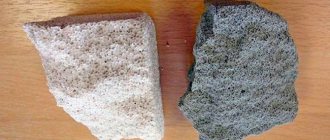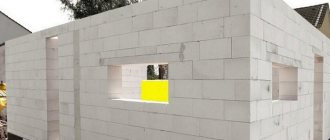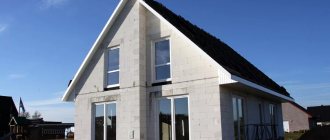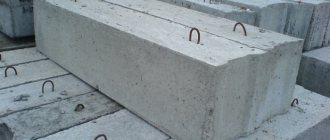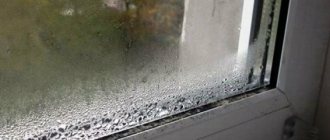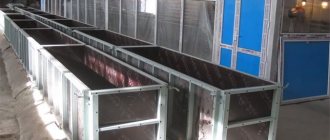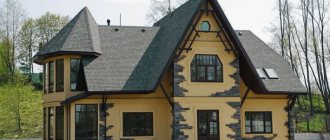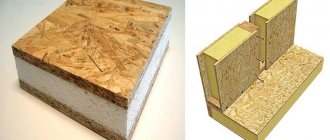Aerated concrete as a building material has been known for more than a century. However, it began to be used for the construction of private houses relatively recently. Interest in this material is constantly growing and the main question is how to choose aerated concrete and which aerated concrete blocks are best used for building a house. Not only the strength of the future building depends on this, but also the speed of its construction and the comfort of living in the future.
Autoclave or non-autoclave
There are 2 types of aerated concrete available for sale:
- Autoclave.
- Non-autoclave.
The first is produced on an industrial scale using special equipment. An autoclave is a large structure, inside which a set of concrete performance characteristics occurs under the influence of temperature and pressure.
The finished product receives the correct shape, and deviations from the specified dimensions do not exceed 1 mm. Autoclave blocks are characterized by a uniform surface structure. This feature ensures high thermal conductivity and resistance to heavy loads.
Non-autoclaved aerated concrete can be made at home, but its properties will differ from factory ones: the products will have a number of deviations in shape and a heterogeneous structure.
When figuring out which aerated concrete is better, you need to familiarize yourself with the characteristics of products from the following brands:
- Aeroc.
- UDK.
- Ytong.
- "Stonelight."
How to choose an aerated concrete block
- Production technology
. To make aerated concrete, natural materials such as sand, cement, lime, and gypsum are required. Gas formation occurs due to the addition of aluminum dust, which begins to react when water is added with cement and lime. But to harden the mass, manufacturers use two methods. - Autoclave technology
involves processing the formed block with saturated steam, which is supplied at high pressure. This type of aerated concrete is highly durable, but is more expensive. It is recommended for the construction of walls. - Non-autoclave technology
consists of heat treatment of the semi-finished product, sometimes drying occurs in the open air. Aerated concrete is cheaper, but it should be used for constructing partitions. - Brand of aerated concrete
. The defining characteristic of aerated concrete blocks is density. It changes in kg/cubic meter. m, and the numerical expression becomes the brand designation after the letter D. The density range ranges from D200 to D1200. The heaviest blocks are used for constructing load-bearing structures of high-rise buildings; grades D500...D600 are optimally suited for private housing construction. And the most porous and lightweight products (D200...D350) are used for thermal insulation of buildings or creating internal partitions. - Compressive strength
. The density of aerated concrete directly affects another important parameter called compressive strength. For designation it is customary to use the corresponding coefficient in MPa. For example, the popular B2.5 block has a compressive strength of 2.5 MPa, and its density is in the range of 700-800 kg/cubic. m. For comparison, for brick this figure reaches 15-20 MPa, therefore aerated concrete blocks are not used for multi-story construction. - Frost resistance
. The most important indicator of aerated concrete for the harsh climatic conditions of Russia is frost resistance. It is determined by the number of freezing and thawing cycles that the material can withstand without deteriorating performance characteristics. The frost resistance range ranges from F15...F100. Builders recommend using blocks with frost resistance above F50 for the construction of external walls. - Types of gas blocks
. There are several varieties available on the domestic market, differing in shape and size. Rectangular structures are considered classics of the genre; experts distinguish several types in this group. - Masonry or wall aerated concrete blocks
are produced for the construction of load-bearing walls. Sometimes they are also used to construct partitions. With a standard height (200 mm) and length (600 mm), they differ in width (200...500 mm). - Special blocks
for partitions with the same length and height parameters have a width of 75...150 mm. - To create jumpers, you can find on sale blocks 500 mm long, 200 mm high and 250...400 mm wide.
Our review included 12 of the best manufacturers of aerated concrete blocks. They can be bought in different regions of our country. When distributing places in the ranking, the opinions of experts and consumer reviews were taken into account.
What thickness to choose aerated concrete
The thickness of the blocks is an important parameter that determines thermal conductivity: the thicker the structure, the better it will retain heat.
For the central regions of the Russian Federation, it is recommended to choose aerated concrete with a heat loss resistance of 3.5 m2/W*K.
The following brands of gas blocks correspond to this parameter:
- D300 - 300 mm.
- D400 - 400 mm.
- D500 - 500 mm.
- D600 - 600 mm.
To reduce the cost of heating the room, it is recommended to build thicker walls. They will evenly distribute the load from heavy reinforced belts, roofing pie and interfloor ceilings.
For a load-bearing wall, it is customary to choose a material with a thickness of 300 mm or more. The optimal height varies from 200 to 250 mm. The higher the product, the fewer rows will be needed. This also reduces the amount of glue consumed, but creates a number of difficulties during laying.
Owner reviews and photos of houses
Much is written about the use of gas silicate blocks on various Internet forums related to construction. Basically, many people praise the material, are satisfied with the results obtained, and advise actively using such blocks. Others, on the contrary, express doubts and dissatisfaction, complaining about problems with cracking and shrinkage. Much depends on the manufacturer of the material and compliance with all technological subtleties of the process.
“...We have to go through the 3rd winter in a house from GB. Wall thickness, 40 cm. Masonry with glue. No insulation. Two floors. Floors - reinforced concrete, foundation - strip, reinforced concrete belts. There are no cracks anywhere yet. The temperature in the house is maintained at 24 degrees. 3000 cubic meters are consumed per year. gas for heating, hot. water, food. It was not by chance that the glue was isolated. The neighbor is building from aerated concrete, but with mortar. They don't skimp on the solution. Now at the masonry stage there are already blocks that are cracked. Here and there they come across. It may have nothing to do with it, but it seems to me that it has an effect...”
Boryspil district, Mikhail
“...We built a summer kitchen at the dacha out of aerated concrete. My husband did the laying himself, and it turned out pretty quickly. Outside, covered with siding, inside, drywall. After two years of use, there is no smell of dampness, the walls do not get wet, everything is fine...”
Angelina Ivanchenko
Strength classes
There are several classes of aerated concrete in terms of strength.
They determine the ability of the material to withstand loads and indicate the areas of its application:
- B1.5 - suitable for the construction of houses with 1-1.5 storeys.
- B2 - for houses with 1.5 and 2.5 storeys.
- B2.5 - designed for buildings with two and three floors.
- B3.5, B5 - durable material that is used in the construction of buildings up to 5 floors.
Strength class tables
Modern classification regulates the following values:
| Brand of aerated concrete | Compressive strength indicators | Average strength (kg/cm²) | |
| D300 (300 kg/m³) | B0.75-B1 | 10-15 | |
| D400 | B1.5- B2.5 | 25-32 | |
| D500 | B1.5- B3.5 | 25-46 | |
| D600 | B2- B4 | 30-55 | |
| D700 | B2-B5 | 30-65 | |
| D800 | B3.5- B7.5 | 46-98 | |
| D900 | B3.5- B10 | 46-13 | |
The innovative material of the D300 series with good strength properties is especially popular. These gas blocks are in demand when building two-story houses. There are also more durable brands with a compressive strength of up to 1100-1200 kg/m³. They are used in multi-story construction or the construction of large-sized objects with increased loads.
The formation of cracks in buildings made of aerated concrete occurs among those developers who use material with a minimum density. Therefore, it is better to focus on autoclave options with a density of D400 or higher.
The main area of application of low-density aerated concrete (D150-D200) is the arrangement of an insulating layer. It will not be possible to choose it for building walls.
Types of gas blocks
The marking of aerated concrete blocks includes the capital letter D and a number indicating the density of the material. For example, D500 is a designation for aerated concrete with a density of 500 kg/m³. Depending on the density of the material, there are three types of blocks:
- thermal insulation,
- structural and thermal insulation,
- structural.
The name of each type also indicates the purpose of the blocks; replacing one type with another is not allowed. Using blocks for other purposes not only threatens to deteriorate the characteristics of the building, but can also lead to its destruction.
Thermal insulation
Thermal insulation materials include aerated concrete grades D300-D400. Due to its low density, such material does not transmit heat well. However, a large number of pores reduces the strength of the material.
Non-load-bearing walls are made from thermally insulating aerated concrete blocks, which during operation do not take any load other than their own weight. Such walls are laid during the construction of buildings that have a spatial frame of reinforced concrete panels or columns. The blocks simply fill the areas of the external walls, leaving openings for windows and doors in them.
The walls of each floor rest on the floors; the maximum height of such a wall is no more than the height of the floor. Therefore, the blocks are not subject to heavy loads.
Structural and thermal insulation
This type of aerated concrete, which includes products of the D500-D900 brands, is used as a universal one. The blocks carry a large load, but their thermal conductivity is low. Such blocks can be used to lay out load-bearing walls of two- or three-story houses, even if the floors are reinforced concrete, and internal partitions. In temperate climates, the walls don’t even need to be insulated. Blocks of this type are most often used in the construction of private houses.
Structural
The density of structural concrete is equal to or exceeds 1000 kg/m³. This type includes blocks of grade D1000 and higher. Such materials are used for the construction of load-bearing walls of multi-story buildings. Due to the high density of the material, the external elements of buildings built in cold climates require mandatory insulation.
Aerated concrete is used not only for the production of wall blocks. Reinforced lintels, beams and slabs for prefabricated floors are also made from this material. But you cannot build a foundation from aerated concrete. Even with high density, this material is capable of absorbing large amounts of moisture, which destroys it over time. For the same reason, it is necessary to carry out horizontal waterproofing between the foundation and the walls made of aerated concrete.
Aerated concrete with or without groove
The advantage of aerated concrete blocks with grooves is ease of transportation, because they have special pockets that are easy to grasp with your hands. Flat models without grooves also have this design feature.
When using the first type, the consumption of adhesive is reduced, and the laying is completed much faster. At the same time, the grooves can cause discomfort when arranging additional blocks, since they often have to be cut down or removed with a grater.
Gas block for partitions
Since aerated concrete has good performance properties, it is actively used in the construction of partitions for zoning the space of rooms. The construction of such structures begins only after the completion of the construction of the external walls.
If the length of the partitions exceeds 8 m and the height is 3.5 m or more, they will have to be additionally reinforced with reinforcing elements. When choosing a thickness, you need to make sure that it can ensure the stability of the wall. Increased strength properties and reliability are ensured by a high-quality layer of cement 1-3 mm thick.
To reduce the pressure on the aerated concrete partition, expansion joints are provided. Their height reaches 20 mm, and the internal space is filled with mineral wool, polyurethane foam or other materials with shock-absorbing properties. Using a similar principle, the edges of the partition are connected to load-bearing objects. The partition is connected to the wall using reinforced concrete structures.
Construction - advantages of gas silicate material
The quality of aerated concrete can be characterized at the following stages:
- purchase of material. The estimated cost of gas silicate blocks is slightly less than bricks. This is due to the production technology using cheaper components, as well as the porous internal structure of the material. With the same thermal insulation properties, the required mass of blocks is less than for brick buildings;
- walling. The process of laying gas silicate blocks is quite simple, allowing you to speed up the pace of laying and reduce the cost of hiring workers.
- interior decoration. It takes minimal time, since low-density blocks are easily processed with any construction tool. Drilling a hole or punching grooves for water pipes is not noticeably difficult compared to brick or concrete buildings.
A significant advantage of the design is the possibility of construction in winter. This is achieved through the use of special adhesives applied in a thin layer into the space between the blocks.
The use of glue, in contrast to cement-sand mortar, eliminates the formation of cold bridges at the joints and loss of energy.
Top 10 manufacturers
The building materials market offers a wide selection of gas blocks from different manufacturers.
Xella
The Xella company is a large manufacturer of building materials, which is based in Germany, but has enterprises in the Russian Federation. It produces modern series of aerated concrete, which are sold not only in Russia, but also in foreign countries.
Over the years of its existence, the brand has won the trust of thousands of consumers, since advanced technologies and innovative developments are used in the production process of blocks.
EuroAeroBeton
EuroAeroBeton has been producing aerated concrete blocks since 2008. The production is located in the Leningrad region. The brand’s engineers use the best modern technologies that allow the development of aerated concrete on an industrial scale.
This became possible due to automated equipment from leading European, Japanese and American companies. The quality of our products is controlled by our own laboratories.
Voronezh Construction Materials Plant
The third position in the ranking of the best producers of aerated concrete is occupied by the Voronezh Construction Materials Plant. The company appeared on the Russian market 55 years ago; current production volumes reach 140 million bricks per year.
Advanced systems and equipment are used in production. At the same time, the manufacturer is constantly modernizing its factories, which ensures high quality products.
LSR
In 4th place on the list is the LSR brand. Construction-Ural". It belongs to the largest LSR group, which produces a wide range of building materials, including aerated concrete blocks. The history of the brand began 50 years ago. The company's factories use advanced equipment from Germany, which increases production rates and ensures better quality indicators.
KZSST
5th place in the ranking belongs to the KZSST enterprise (Kazan Plant of Silicate Wall Materials). The company occupies a leading position in terms of sales volumes in the Republic of Tatarstan and the entire Volga region. Production figures reach 230 million bricks and 100 thousand cubic meters. m. autoclave-type gas blocks. The brand's assortment includes face bricks in 10 colors and different options for aerated concrete blocks.
Lipetsk silicate plant
The 6th position is occupied by the Lipetsk Silicate Plant, which is included in the ranking of the 100 best producers of silicate blocks. The enterprise was founded in 1938. Today, the company’s products are bought not only in the Lipetsk region, but also in other parts of the Russian Federation. In 2012, the manufacturer was certified ISO 9001:2008, which is a guarantee of high quality.
Glavnovosibirskstroy
Glavnovosibirskstroy is another popular manufacturer of building materials that entered the market in 1963. The holding consists of a number of companies engaged in the production and sale of gas silicate blocks with good performance characteristics.
Over the entire period of operation, the company has sold more than 13 million square meters. m of residential facilities and 500 industrial facilities. Several years ago, the holding set a goal to increase production volume; the annual capacity is now 360 cubic meters. m. per year.
PESP
PESP (Perm Silicate Panel Plant) is one of the leaders of the local market and produces gas blocks with different parameters. The company employs more than 5 thousand people, and its main area of activity is the implementation of various projects for the construction of buildings for various purposes. The company's products are characterized by increased strength, resistance to heavy loads and low thermal conductivity.
Saratov building materials plant
Took 9th place. In 2001, the holding received the “Golden Standard” award, confirming the reliability of the brand. The production process uses advanced equipment and many years of experience of leading engineers.
Pros and cons of houses made of gas silicate blocks
Manufacturers of such building finishing claim that buildings based on gas silicate can be compared with wooden buildings in terms of microclimate. At the same time, the construction procedure is not particularly complicated or labor-intensive, so all work can be completed without the involvement of specialists and in a short time.
This material is able to guarantee an acceptable rate of heat and air exchange, this is possible due to the porous surface of the gas silicate. It’s quite warm inside the building during cold weather, but waterproofing will be necessary to maintain the temperature. To ensure that the surface can breathe, you will need to cover it using foam plastic.
When constructing a building, it is necessary to maintain a minimum interval of seams between blocks. It is this indicator that directly affects heat transfer.
The simplicity of construction procedures depends on the geometry of the material. If the blocks are smooth, then erecting the building is quite easy. During the construction process you will need to use special glue. The use of a cement mixture will result in the formation of large joints. Because of this, the thermal conductivity and strength of the surface will be significantly reduced. Due to the heaviness of the blocks, it will be quite difficult to do the work yourself; you will need help.
During construction you will need to take into account a number of the following nuances:
- This material is ideal for the construction of 2-story buildings, but no more. If the load on the blocks is too great, the material may not withstand and collapse.
- After constructing the first floor of the house, it is necessary to make a monolithic strapping belt. Only this will allow the weight of the second floor and roof to be evenly distributed to the lower levels. The 3rd row of finishing will need to be reinforced using a mesh based on metal or sheets.
- Monolithic strip foundations must be used as the basis for such substrings, so it will not be possible to save money during the construction process.
- The constructed walls shrink over the course of a year. This nuance must be taken into account when planning internal surface cladding. Due to shrinkage, plaster can quickly crack, so it is preferable to use drywall.
